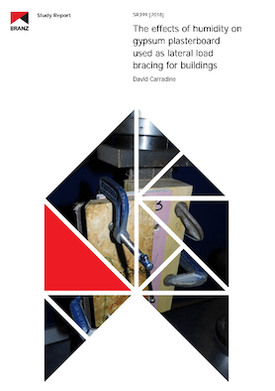
SR399 The effects of humidity on gypsum plasterboard used as lateral load bracing for buildings (June 2018)
Product Description
Currently in New Zealand, a major portion of 1 and 2-storey buildings are constructed to NZS 3604:2011 Timber-framed buildings using light timber framing with gypsum plasterboard linings serving as the primary lateral load-resisting system. Due to the nature of the materials comprising plasterboard, environmental moisture levels have the potential to reduce the effectiveness of plasterboard as a structural component. This includes potentially lower earthquake and wind bracing ratings as determined using the P21 test method.
This project investigated the relationships between and the performance of plasterboard linings as lateral load-resisting elements in buildings. Testing was conducted on plasterboard at different humidity levels to determine how fastener holding capacity was affected. Results were considered in the context of humidity levels that would likely be experienced in these low-rise buildings throughout New Zealand.
The results indicated there was some degradation in plasterboard performance at higher humidity levels. However, the decreases were not considered to be significant enough to warrant changes in current test standards and building practices for buildings constructed according to NZS 3604:2011.
Product Information
| Publication date | June 2018 |
|---|---|
| Author | David Carradine |
| System number | SR399 |